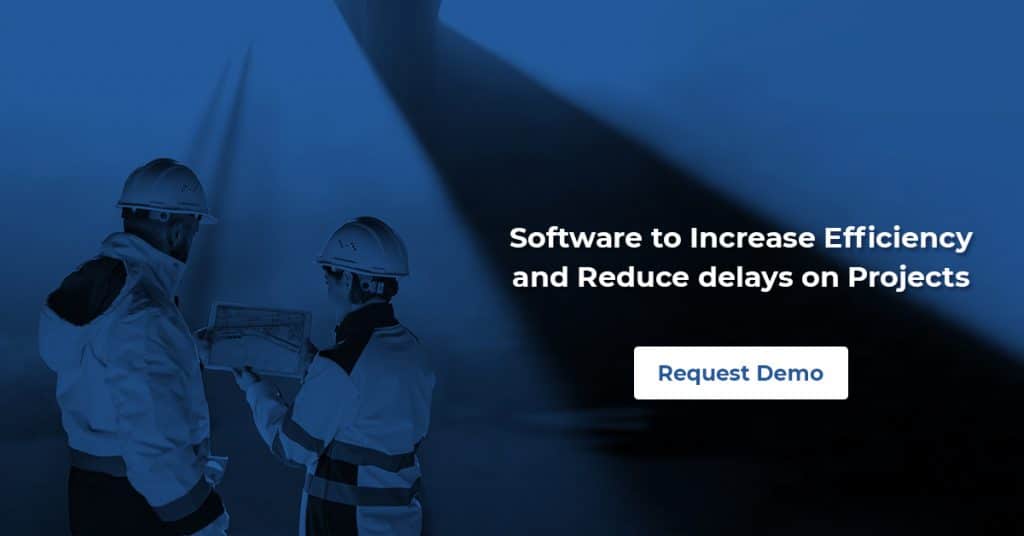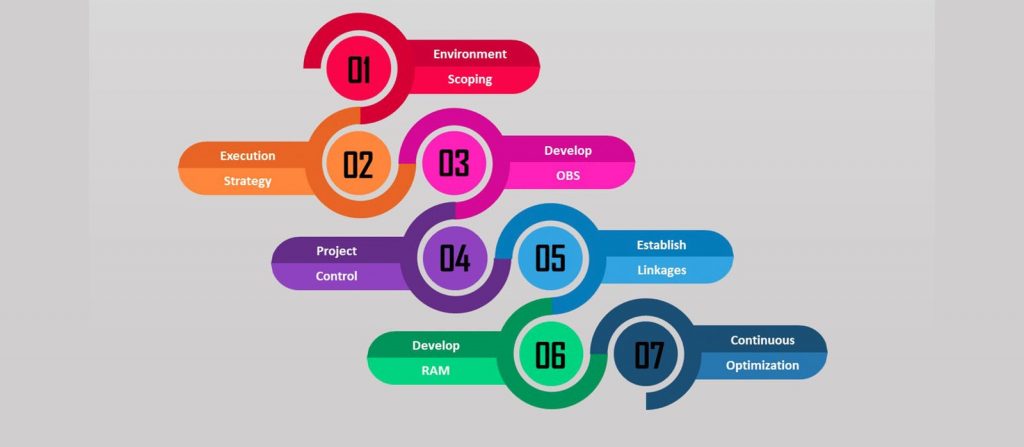- Blog
- 14 Nov 2019
7 steps to define Project’s Organization Breakdown Structure (OBS)

The planning, organizing and delivery of large projects are extremely complex. The success or failure of such projects are determined by the project strategy.

Large projects also involve many different stakeholders entering and exiting the project life cycle at different stages with different roles and responsibilities. Some of them can even have conflicting interests.
The complexity of large projects requires division, allocation and execution of work among highly specialized stakeholders such as contractors, sub-contractors, suppliers etc. But, it also leads to significant interface and timing risks among the various stakeholders throughout the project life cycle.

Investing time in defining the appropriate project strategy, project organization and the definition of roles and responsibilities upfront enables better project execution speed and control when the rubber meets the road.
The 7 steps to effective organization breakdown structures
- Scope the project management environment and key stakeholders
- Develop the project execution strategy
- Develop the Organization Breakdown Structure for the project (OBS) covering Engineering, Procurement, Construction and Installation.
- Identify the project control requirements
- Link the OBS to Work Breakdown Structure (WBS)
- Develop the Responsibility Assignment Matrix (RAM)
- Optimize the WBS, OBS and Control accounts
1. Scoping the project management environment and key stakeholders
Always start by asking if this project is part of a larger program / portfolio or if it is a standalone project. Evaluate the business case of the project, known risks, geographical location, availability of resources, organizations involved, their structures, cultures, climatic and political conditions, standards to be followed, technologies to be used.
A clear understanding of these factors will set us on a correct path for subsequent steps in developing the organization breakdown structure. After understanding the project environment, you can better identify the key project stakeholders.
Typical project stakeholders include;
- The owner
- Sponsors
- Consultants
- Contractors
- Suppliers
- Government bodies
- Industry bodies
- Portfolio managers
- Program managers
- Project managers
- Project teams
2 . Developing the project execution strategy
After having identified the key stakeholders of the project and the work breakdown structure (WBS), it is time to think about ‘How to perform?’ the work in the WBS.
There are multiple factors influencing the project’s execution strategy such as – make or buy decisions, sub-contracting, scheduling flexibility, constructability, time-cost-scope constraints, alternatives analysis, value analysis, value engineering, concurrent engineering, the triple constraints of time, cost and scope, agility, skills, knowledge, experience, risk transference. These factors heavily influence the decisions that shape project’s development life cycle.
This is the time to have clarity on;
- Construction Work Areas
- Path Of Construction (POC)
- Engineering Work Packages (EWP) plan
- Construction Work Packages (CWP) plan
- Procurement Work Packages (PWP) plan
- Installation Work Packages (IWP) plan
Investing time and effort to develop a project execution strategy pays huge dividends during project execution. This is evident from the following lessons shared by fellow project managers.
“When we completed the WBS of a very large project, we realized that we do not have access to the right skilled engineers to develop some of the complex work packages. Multiple rounds of project strategy development brainstorming helped us to identify a sub-contractor who had the right skills to do those complex work packages, which helped us to complete the complex project which had a huge penalty clause for delay. That professional association matured to a strategic partnership which helped us to deliver multiple projects successfully.” – Senior project manager
“It is the project strategy based on prefabricated construction which helped us to shorten the schedule and deliver the project ahead of schedule” – A Project Manager
“The decision to do distributed concurrent engineering across five engineering teams from five locations helped us to reduce the engineering time” – Engineering project manager
“During the construction phase only 35% is the productive time. Rest of the time goes into waiting, tool changing, material transfer, early exits etc” CII Study
Every project is unique. Time spent in project execution strategy and project planning is a wise investment. A good project execution strategy, for example Advanced Work Packaging (AWP), Agile development, Hybrid development etc are the foundation for project success, because it helps us address most of the risks upfront.
3. Developing the organization breakdown structure (OBS) for the project
Organization Breakdown Structure (OBS) is a hierarchical relationship of the organization, including subcontractors, responsible for managing a designated scope of work within the work breakdown structure (WBS).
A project OBS is a depiction of the project organization. It indicates the reporting relationships within a project. A project OBS reflects the way the project is functionally organized.
It is a direct representation of the hierarchy and organization within a project. The project organization breakdown structure provides resources for the work identified in the Work Breakdown Structure (WBS).
Further, a project OBS helps management to establishing the most efficient organization, by considering the availability and capability of management and technical staff, including subcontractors, to achieve project objectives.
For example, consider a project for construction of a warehouse. The project team can be broken down into owner, project management and procurement, contractor engineering, and subcontractor construction organizations. Furthermore, the contractor engineering organization may include disciplines such as civil, mechanical, and electrical.
Different types of organization breakdown structures
Functional organization
- Individuals are assigned to work according to functions such as engineering, procurement, design, quality, accounts etc.
- Individuals in these functional groups are then assigned to multiple projects and at the same time they will remain part of the function – for example, accounts.
- In most of the functional organizations, the functional managers command more power than the project managers.
Client based organization
Organized to handle different types of clients based on their nature of work (energy, solar, automobile, aviation, transportation, hospitals, etc.) The structuring can also be according to geographic lines like North America, Latin America, Middle East and North Africa (MENA).
Dedicated Project / Program Organization
For those who don’t know the difference between a projects and programs; Programs are a collection of interrelated projects, which when done together provides more value than doing them one after the other.
For example, an integrated metro transport program will have projects like metro rail, water metro, road quality improvement, cycling tracks, improved bus services, road safety awareness projects as part of the program. When all these projects are successfully done, the programs objective is accomplished. Project managers manage the individual projects and all of them report to the program manager.
- The project managers build, develop and manage their project teams
- The program managers develop the program management teams. In some cases, they may even appoint the project managers.
- In this type of organizations, the project / program managers have very high degree of decision-making authority
Matrix Organization
Whenever the team members have more than one boss to report to (dual reporting), you are in a matrix organization. In these organizations, a project team member remains a member of their functional organization, but is assigned to a specific project, and is given assignments by the project manager rather than by the functional manager.
Control account managers (CAMs) on a project can also fulfil a role as functional managers. There are three flavours of matrix organizations;
- Strong matrix – Project / Program managers have more authority than the functional managers
- Weak matrix – Functional managers have more authority than the project / program managers
- Balanced matrix – Both the project manager and the functional managers have same level of authority
Self-organizing teams
By definition, self-organizing teams organize themselves to get the work done. Instead of the manager allocating work to the team members, the team decides who will do what. These kinds of teams are often seen in agile environments where projects have very short milestones to accomplish and are performed by inter disciplinary teams.
These are various possible organizational breakdown structures used for project execution. Based on the nature of the project, the nature of the stakeholders and organizational types, we have to develop the project’s organizational breakdown structure which can be a mix of all team flavours discussed above (composite in nature).
4. Identifying the project control requirements
Code Of Accounts (COA) is the unique accounting identification number provided for work packages. When different organizations work on the same project (design, construction, project management consultants, procurements, plumbing and electrical) developing a commonly agreed upon COA is crucial for effective project accounting.
Designing the Code of Accounts (COA) in alignment to the project control requirements of the key stakeholders upfront is the key for effective project control.
A well-defined code of accounts caters to;
Classifying estimate items, budgets and expenditures for cost control and capitalization
- Facilitating estimating and analysis of project cost data
- Summarizing cost data
- Assigning responsibility for budgets
- Complying with accounting, taxation and regulatory requirements
- Providing a means to link accounting, cost reporting, cost and schedule control
- Performance and productivity measurement analysis
- Cost and schedule forecasting
- Facilitating audits and reporting accuracy
Account code content characteristics
| Account content characteristic | Example |
| Accounting | Cost group |
| Geographical | Area |
| Physical | Product, Unit |
| Resource | Discipline, Cost Type |
| Activity | WBS, work type, activity type, discipline |
| Timing | Budget year, Fiscal year, quarter |
Reference : RP 20R-98 Project Code of Accounts of TCM framework by AACE
5. Linking the OBS and the WBS
At this stage, the project’s work breakdown structure is ready, and the project’s organizational breakdown structure is also ready, the accounting categories (Code of Accounts) are agreed upon and the next step is to link the WBS and OBS.
In other words, it is time to decide which project organization is going to perform which work package.
6. Developing the responsibility assignment matrix
Translating the WBS-OBS linkages of step-5 into a tabular format gives us the Responsibility Assignment Matrix (RAM). There are multiple variants of RAM like the RACI (Responsible, Accountable, Consultative, Information), RASCI (Responsible, Accountable, Sign off, Consultative, Information. Costs may also be included in the RAM. This is often found in EVM systems and is called a monetized RAM.
7. Optimizing the WBS, OBS and the Control accounts
While the code of accounts coding structure is organization specific the WBS and OBS definitions are project specific. The code of accounts acts as the interface to financial accounting and budget control.
The monitoring and control need of several stakeholders must be met. To achieve this, maintaining alignment of WBS, OBS, Code of accounts and the interfaces to other organizational systems is very important. This calls for splitting and merging of work packages and the organizational charts. Doing that, further requires collective wisdom and commitment of the stakeholders.
“Almost 70% of the organizations have partial implementation of Earned Value Management systems and forecasting, because of improper definition and alignment of the WBS, OBS and COA and their interfaces to other organizational systems” – Manish, COO, Wrench solutions
There lies the business case for defining the project’s organization breakdown structure (OBS), Work breakdown structure (WBS), Code of Accounts (COA), interfaces to external systems while planning the projects.
Expert in agile, predictive and hybrid project management. Researches on the application of Artificial Intelligence for better project outcomes. Works as a domain expert at Wrench Academy, the knowledge management division of Wrench Solutions, the makers of Smart Project Digital PMO.
Related Posts

What is an EDMS?
EDMS has become popular in the EPC world in the last decade, especially after the pandemic. What is EDMS? At its core, EDMS is an electronic document management system or a software that organises and…
- 20 Mar 2025

The Role of AI in Project Monitoring
As AI continues to make inroads into every industry in the world and the buzz around it continues to grow, we’re seeing EPC organisations leave behind their historical hesitation about emerging technologies; in fact we’re…
- 13 Mar 2025
Archives
- March 2025
- February 2025
- January 2025
- November 2024
- October 2024
- September 2024
- August 2024
- July 2024
- June 2024
- May 2024
- April 2024
- March 2024
- January 2024
- December 2023
- November 2023
- September 2023
- August 2023
- July 2023
- June 2023
- May 2023
- April 2023
- March 2023
- February 2023
- January 2023
- December 2022
- November 2022
- September 2022
- June 2022
- May 2022
- April 2022
- March 2022
- January 2022
- November 2021
- October 2021
- July 2021
- June 2021
- May 2021
- March 2021
- February 2021
- January 2021
- December 2020
- November 2020
- September 2020
- August 2020
- June 2020
- April 2020
- March 2020
- February 2020
- January 2020
- November 2019
- October 2019
- September 2019
- August 2019
- April 2019
- March 2019
- December 2018
- October 2018
- September 2018
- August 2018
- July 2018
- June 2018
- May 2018
- April 2018
- January 2018
- November 2017
- October 2017
- September 2017
- May 2017
- April 2017
- March 2017
- February 2017
- January 2017
